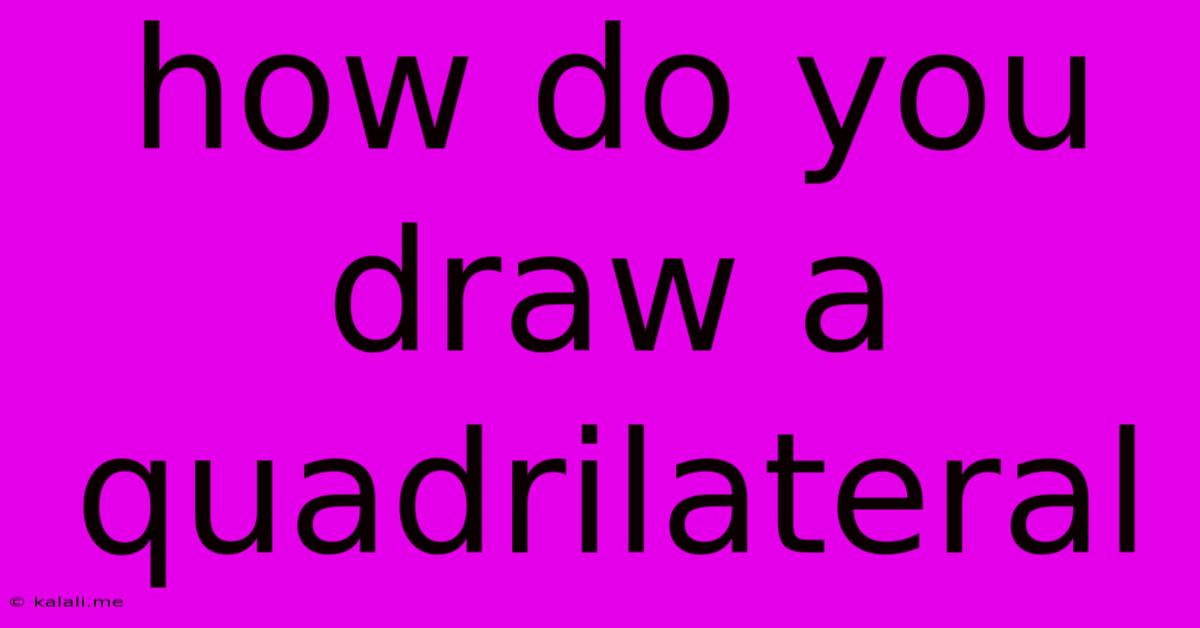How Do You Draw A Quadrilateral
Kalali
May 09, 2025 · 4 min read

Table of Contents
How to Draw a Quadrilateral: A Step-by-Step Guide for Beginners and Beyond
Quadrilaterals, four-sided polygons, are fundamental shapes in geometry, appearing everywhere from architecture to art. This guide provides a comprehensive approach to drawing quadrilaterals, covering basic techniques and exploring different types. Understanding how to draw them accurately is crucial for various applications, from sketching to computer-aided design (CAD). This article will equip you with the knowledge to draw various quadrilaterals with confidence.
Understanding Quadrilaterals: Types and Properties
Before diving into drawing techniques, let's review the different types of quadrilaterals. Each type has specific properties that influence how you draw them:
- Square: All four sides are equal in length, and all four angles are right angles (90 degrees).
- Rectangle: Opposite sides are equal in length, and all four angles are right angles.
- Rhombus: All four sides are equal in length, but angles are not necessarily right angles.
- Parallelogram: Opposite sides are parallel and equal in length.
- Trapezoid (Trapezium): At least one pair of opposite sides are parallel.
- Kite: Two pairs of adjacent sides are equal in length.
Essential Tools for Drawing Quadrilaterals
While you can sketch quadrilaterals freehand, using tools enhances accuracy and precision. Here's what you'll need:
- Pencil: A standard HB or 2B pencil is ideal.
- Ruler: For measuring and drawing straight lines. A set square or protractor can also be helpful for specific angles.
- Eraser: For correcting mistakes.
- Paper: A clean sheet of paper provides a good drawing surface.
Drawing Different Types of Quadrilaterals
Let's explore how to draw some common quadrilaterals step-by-step:
1. Drawing a Square
- Draw a straight line: Using your ruler, draw a horizontal line of your desired length. This will be one side of your square.
- Draw perpendicular lines: At each end of the line, draw a perpendicular line of the same length using your ruler and set square (or by carefully measuring a 90-degree angle).
- Connect the lines: Connect the ends of the perpendicular lines to complete the square.
2. Drawing a Rectangle
The process is similar to drawing a square, but the lengths of the horizontal and vertical sides will be different.
- Draw a base line: Draw a horizontal line of your desired length.
- Draw the sides: At each end, draw perpendicular lines of a different length than the base line.
- Complete the shape: Connect the ends of the vertical lines to complete the rectangle.
3. Drawing a Parallelogram
- Draw the base: Draw a line for the base of the parallelogram.
- Draw a parallel line: Draw another parallel line to the base, of the same length, to form the opposite side.
- Connect the ends: Draw two slanted lines connecting the ends of the parallel lines to complete the parallelogram. The angle of the slanted lines determines the shape of the parallelogram.
4. Drawing a Rhombus
Similar to a parallelogram, but with all sides being equal.
- Draw the base: Start with a straight line.
- Draw equal adjacent sides: Using a compass or ruler, draw two equal lines at an angle from each end of the base.
- Close the shape: Connect the ends of those two lines to complete the rhombus. Remember all sides should be equal in length.
5. Drawing a Trapezoid
- Draw two parallel lines: Begin by drawing two parallel lines of different lengths.
- Connect the ends: Draw two lines connecting the ends of the parallel lines, creating a trapezoid.
6. Drawing a Kite
- Draw two intersecting lines: Draw two lines intersecting each other. The point of intersection doesn’t need to be in the middle.
- Draw equal adjacent sides: From each end of one line segment, draw equal length lines to the ends of the other line segment.
- Connect the lines: Connect the endpoints to form the kite.
Beyond the Basics: Advanced Techniques
Once you master these basic shapes, you can explore more advanced techniques:
- Using construction methods: Learn geometrical construction methods using compasses and rulers to create precise quadrilaterals with specific angle measurements.
- Drawing irregular quadrilaterals: Practice drawing quadrilaterals with varying side lengths and angles.
- Digital drawing: Explore using digital drawing tools and software to create and manipulate quadrilaterals.
Drawing quadrilaterals is a fundamental skill with wide applications. By following these steps and practicing regularly, you'll develop proficiency and confidence in drawing these essential geometric shapes. Remember, practice makes perfect!
Latest Posts
Latest Posts
-
Identify The Type For Each Quadrilateral
May 10, 2025
-
Why Is The Inner Mitochondrial Membrane Folded
May 10, 2025
-
What Percent Is 20 Of 60
May 10, 2025
-
37 C Is What In Fahrenheit
May 10, 2025
-
Can A Quadrilateral Have 4 Obtuse Angles
May 10, 2025
Related Post
Thank you for visiting our website which covers about How Do You Draw A Quadrilateral . We hope the information provided has been useful to you. Feel free to contact us if you have any questions or need further assistance. See you next time and don't miss to bookmark.